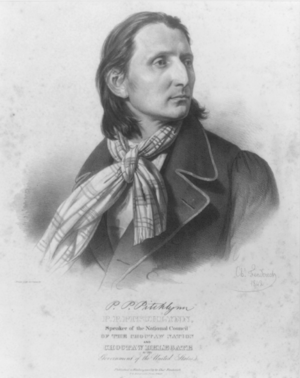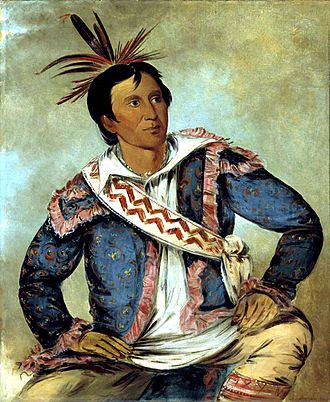Peter Pitchlynn facts for kids
Quick facts for kids
Peter Perkins Pitchlynn
|
|
|---|---|
| Hatchootucknee | |
 |
|
| Chief of the Choctaw Republic | |
| In office 1864–1866 |
|
| Preceded by | Samuel Garland |
| Succeeded by | Allen Wright |
| Choctaw Delegate to the United States | |
| In office 1845–1861 |
|
| In office 1866–1881 |
|
| Personal details | |
| Born |
Hatchootucknee
("Snapping Turtle") January 30, 1806 Noxubee, Choctaw Nation |
| Died | January 17, 1881 (aged 74) Washington, D.C., U.S. |
| Resting place | Congressional Cemetery |
| Nationality | |
| Political party | Independent |
| Education | University of Nashville |
| Occupation |
|
| Known for | Defending Choctaw lands and monetary claims in Washington, promoting education for Indian youth |
Peter Perkins Pitchlynn (January 30, 1806 – January 17, 1881) was an important leader of the Choctaw people. His Choctaw name was Hat-choo-tuck-nee, meaning "Snapping Turtle." He was part Choctaw and part Anglo-American.
Pitchlynn served as the main chief of the Choctaw Republic from 1864 to 1866. He also worked as a special representative, called a Delegate, for the Choctaw Nation in Washington, D.C.. He spent many years defending Choctaw lands and rights.
He believed strongly in education. In 1825, he helped start the Choctaw Academy, a school for Choctaw boys in Kentucky. He also worked to stop the sale of alcohol in Choctaw lands.
After the American Civil War, Pitchlynn returned to Washington, D.C. He continued to represent the Choctaw Nation. He worked to get fair treatment and payments for lands the Choctaw had sold to the United States. He died in Washington, D.C., and is buried there.
Contents
Early Life and Education
Peter P. Pitchlynn was born on January 30, 1806, in Noxubee County, Mississippi. His mother was Sophia Folsom, who was Choctaw and part Anglo-American. Her Choctaw name was Lk-lo-ha-wah. His father was Major John Pitchlynn, who was of Scottish descent. John Pitchlynn was raised by the Choctaw people and worked as an interpreter for George Washington.
The Choctaw people followed a matrilineal system. This means that children belonged to their mother's family and clan. So, Peter gained his status in the tribe through his mother's family.
Peter was one of ten children. He went to boarding schools in Tennessee and later graduated from the University of Nashville. This was considered a very good school at the time.
After finishing his education, Pitchlynn returned home to Mississippi. He became a farmer. In 1824, he became the head of the Lighthorse, the Choctaw Nation's mounted police. One of his jobs was to remove alcohol from tribal lands.

Family Life
Peter Pitchlynn married his first cousin, Rhoda Folsom. They were married by a missionary named Reverend Cyrus Kingsbury. They had several children together, including Lycurgus, Peter P. Jr., Leonidas, Rhoda Mary, and Malvinia. After Rhoda passed away, Pitchlynn married Caroline Lombardy. They had one daughter named Sophia.
Pitchlynn owned enslaved African Americans. However, he was not strongly attached to the practice. After the Emancipation Proclamation ended slavery, he accepted it without protest.
Career and Leadership
Pitchlynn was well-educated in both Choctaw and European-American cultures. He worked hard to improve life for his people. He helped ban the sale of alcohol in Choctaw territory.
He believed that education was very important. In 1825, he convinced the National Council to create the Choctaw Academy. This school was in Kentucky and sometimes accepted students from other Native American tribes. Pitchlynn stayed very involved with the school.
In 1830, Pitchlynn was elected to the National Council of the Choctaw. Because he spoke both English and Choctaw, he was a good link between the Choctaw and the U.S. government. He moved with the Choctaw people to Indian Territory (which is now Oklahoma) in the 1830s.
The famous English author Charles Dickens met Pitchlynn on a steamboat. Dickens described Pitchlynn as a "remarkably handsome man" with a "bright, keen, dark, and piercing eye." Pitchlynn told Dickens that the Choctaw people needed to learn about the ways of the white settlers to survive.
In 1840, Pitchlynn became a teacher and superintendent at the Choctaw Academy. The school later moved to the Choctaw Nation in Indian Territory. Pitchlynn also discussed the need for a school for girls.
In 1845, Pitchlynn was chosen as the Choctaw Delegate to Washington, D.C. This role was like being an ambassador. He represented the Choctaw Nation to the U.S. government. He also helped arrange for more Choctaw people to move from Mississippi to Indian Territory by steamboat.
Civil War and Later Years
In 1861, when the American Civil War began, Pitchlynn was in Washington, D.C. He quickly returned to the Choctaw Nation. He wanted the Choctaw to stay neutral or support the Union. However, after an invasion by Texan forces, the Choctaw Nation was pressured to join the Confederacy. This divided the Choctaw people.
Pitchlynn was elected Principal Chief of the Choctaws in 1864. He served until 1866. In 1866, he went back to Washington to make peace with the United States. He also worked to stop the U.S. government from trying to settle Indian Territory. While there, he met Queen Emma of Hawaii. They shared their cultures, marking a unique meeting between the Choctaw and Hawaiian nations.
After his time as chief, Pitchlynn returned to Washington, D.C., as the Choctaw Delegate. He continued to fight for the Choctaw's land claims in Mississippi. These lands had been sold under pressure to the United States in 1830. He gathered information on this issue since the 1850s.
Pitchlynn joined the Lutheran Church and became an important member of the Masonic Order. He spoke to the President and many government groups to defend Choctaw claims.
Peter Pitchlynn died in Washington, D.C., in 1881. He was buried in Congressional Cemetery. He was one of the first Native American leaders buried there.
Pitchlynn shared a traditional story about the Choctaw people's origin:
- The Choctaw believed their ancestors came from a great sea.
- They were very numerous and covered the shore.
- They traveled across streams, hills, mountains, forests, and prairies.
- They built mounds in beautiful valleys.
- They did this to show the "Master of Life" that they were grateful.
Legacy and Honors
- The Choctaw Nation placed a monument at his gravesite in Congressional Cemetery to honor him.
- His important papers are kept at the University of Oklahoma, in the Western Histories Collection.
See also


